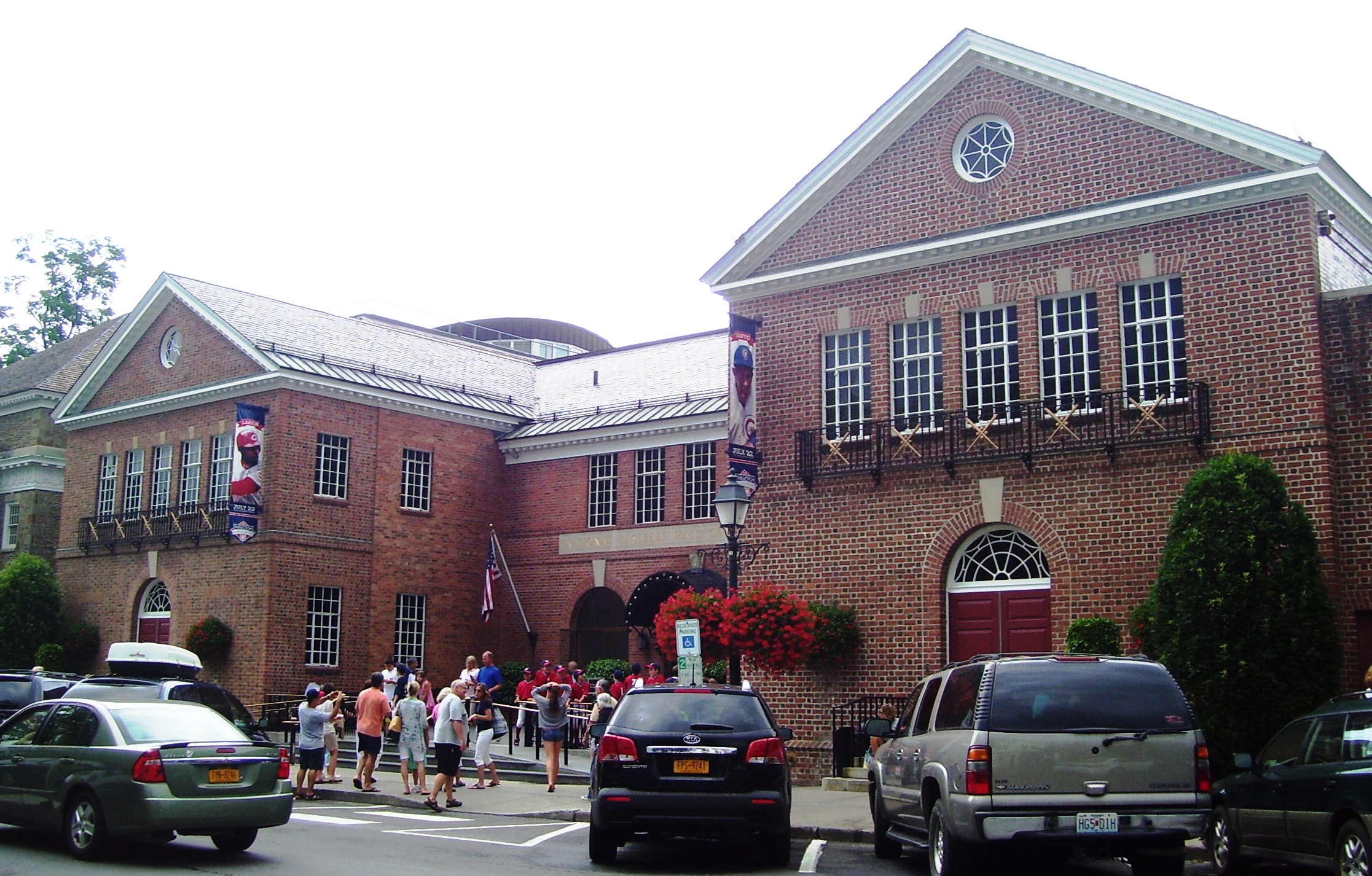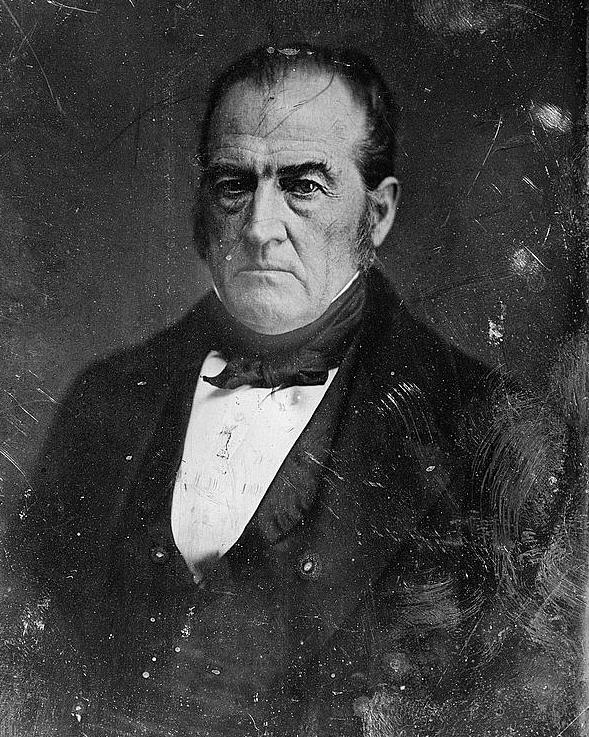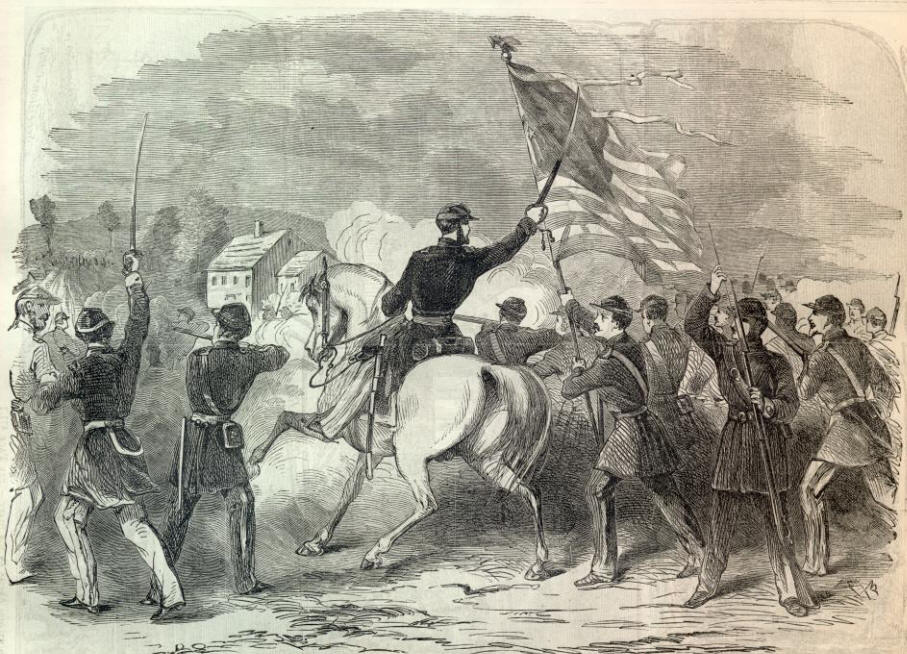|
John Converse Starkweather
John Converse Starkweather (February 23, 1829November 15, 1890) was a general in the Union Army during the American Civil War. Early life and career John C. Starkweather was born in Cooperstown, New York, the eldest son of George A. Starkweather and Elizabeth (Converse) Starkweather. He married Louisa A. Hallett, the daughter of William P. and Rachel Ray Hallet. He graduated from Union College, class of 1850, and studied law and was admitted to the bar in 1857. He moved to Milwaukee, Wisconsin, and practiced law there until 1861. Civil War On May 17, 1861, he was made colonel of the 1st Wisconsin Volunteer Infantry Regiment (3 Months) and took part in the battles of Battle of Hoke's Run (also known as Falling Waters), July 2, 1861, and of Edmunds Ferry, July 29, 1861. He was mustered out on August 21, 1861. Re-organizing his regiment for three years, by special order of the War Department, he again enlisted and served in Kentucky and northern Alabama. In command of a brigade ... [...More Info...] [...Related Items...] OR: [Wikipedia] [Google] [Baidu] |
Cooperstown, New York
Cooperstown is a village in and county seat of Otsego County, New York, United States. Most of the village lies within the town of Otsego, but some of the eastern part is in the town of Middlefield. Located at the foot of Otsego Lake in the Central New York Region, Cooperstown is approximately southwest of Albany, southeast of Syracuse and northwest of New York City. The population of the village was 1,852 as of the 2010 census. Cooperstown is the home of the National Baseball Hall of Fame and Museum. The Farmers' Museum in the village opened in 1944 on farmland that had once belonged to James Fenimore Cooper. The Fenimore Art Museum and Glimmerglass Opera are also based here. Most of the historic pre-1900s core of the village is included in the Cooperstown Historic District, which was listed on the National Register of Historic Places in 1980; its boundaries were increased in 1997 and more contributing properties were identified. History Native American use Before E ... [...More Info...] [...Related Items...] OR: [Wikipedia] [Google] [Baidu] |
George A
George may refer to: People * George (given name) * George (surname) * George (singer), American-Canadian singer George Nozuka, known by the mononym George * George Washington, First President of the United States * George W. Bush, 43rd President of the United States * George H. W. Bush, 41st President of the United States * George V, King of Great Britain, Ireland, the British Dominions and Emperor of India from 1910-1936 * George VI, King of Great Britain, Ireland, the British Dominions and Emperor of India from 1936-1952 * Prince George of Wales * George Papagheorghe also known as Jorge / GEØRGE * George, stage name of Giorgio Moroder * George Harrison, an English musician and singer-songwriter Places South Africa * George, Western Cape ** George Airport United States * George, Iowa * George, Missouri * George, Washington * George County, Mississippi * George Air Force Base, a former U.S. Air Force base located in California Characters * George (Peppa Pig), a 2-year-old ... [...More Info...] [...Related Items...] OR: [Wikipedia] [Google] [Baidu] |
Auburn, New York
Auburn is a city in Cayuga County, New York, United States. Located at the north end of Owasco Lake, one of the Finger Lakes in Central New York, the city had a population of 26,866 at the 2020 census. It is the largest city of Cayuga County, the county seat, and the site of the maximum-security Auburn Correctional Facility, as well as the William H. Seward House Museum and the house of abolitionist Harriet Tubman. History The region around Auburn had been Haudenosaunee territory for centuries before European contact and historical records. Auburn was founded in 1793, during the post-Revolutionary period of settlement of western New York. The founder, John L. Hardenbergh, was a veteran of the Sullivan-Clinton campaign against the Iroquois during the American Revolution. Hardenbergh settled in the vicinity of the Owasco River with his infant daughter and two African-American indentured servants, Harry and Kate Freeman. After his death in 1806, Hardenbergh was buried in Aub ... [...More Info...] [...Related Items...] OR: [Wikipedia] [Google] [Baidu] |
List Of American Civil War Generals (Union)
Union generals __NOTOC__ The following lists show the names, substantive ranks, and brevet ranks (if applicable) of all general officers who served in the United States Army during the Civil War, in addition to a small selection of lower-ranked officers who received brevets as general officers; while some 1,600 officers received or were nominated for brevets as general officers in the course of the war (or immediately following it for service during the war),Hunt, Roger D. and Brown, Jack R., Brevet Brigadier Generals in Blue. Olde Soldier Books, Inc.,, Gaithersburg, MD, 1990. only a small selection is listed here; only those who were killed in action, served as department heads within the army, had revoked or incomplete appointments or became U.S. President are listed here. In addition to their names and ranks, there is a small set of notes after every entry listing Medal of Honor or Thanks of Congress citations, West Point graduation dates, important political or Army office ... [...More Info...] [...Related Items...] OR: [Wikipedia] [Google] [Baidu] |
Tennessee In The American Civil War
The American Civil War made a huge impact on Tennessee, with large armies constantly destroying its rich farmland, and every county witnessing combat. It was a divided state, with the Eastern counties harboring pro-Union sentiment throughout the conflict, and it was the last state to officially secede from the Union, in protest of President Lincoln's April 15 Proclamation calling forth 75,000 members of state militias to suppress the rebellion. Although Tennessee provided a large number of troops for the Confederacy, it would also provide more soldiers for the Union Army than any other state within the Confederacy. In February 1862, some of the war's first serious fighting took place along the Tennessee and Cumberland rivers, recognized as major military highways, and mountain passes such as Cumberland Gap were keenly competed-for by both sides. The Battle of Shiloh and the fighting along the Mississippi brought glory to the little-known Ulysses S. Grant, while his area comm ... [...More Info...] [...Related Items...] OR: [Wikipedia] [Google] [Baidu] |
Surgeon General Of The United States Army
The Surgeon General of the United States Army is the senior-most officer of the U.S. Army Medical Department (AMEDD). By policy, the Surgeon General (TSG) serves as Commanding General, U.S. Army Medical Command (MEDCOM) as well as head of the AMEDD. The surgeon general's office and staff are known as the Office of the Surgeon General (OTSG) and are located in Falls Church, Virginia. Since 1959, TSG has been appointed in the grade of lieutenant general. By law, TSG may be appointed from any of the six officer branches of the AMEDD. However, prior to the 43rd Surgeon General, Lt. Gen. Patricia Horoho — an Army Nurse Corps officer — all appointed and confirmed surgeons general have been Medical Corps officers — military physicians. The incumbent Surgeon General is medical administrator Lieutenant General R. Scott Dingle, a Medical Service Corps officer. The 44th Army Surgeon LTG Nadja West retired on July 19, 2019. Duties As a commanding general, TSG provides advice an ... [...More Info...] [...Related Items...] OR: [Wikipedia] [Google] [Baidu] |
William Alexander Hammond
William Alexander Hammond (28 August 1828 – 5 January 1900) was an American military physician and neurologist. During the American Civil War he was the eleventh Surgeon General of the United States Army (1862–1864) and the founder of the Army Medical Museum (now the National Museum of Health and Medicine). He was the first American physician to devote himself entirely to neurology, the author of the first American treatise about neurology, and one of the founders of the American Neurological Association. Biography Born in Annapolis (Maryland), Hammond grew up in Harrisburg (Pennsylvania). He received his M.D. from New York University at the age of 20. After his internship and a few months in private practice he became assistant-surgeon in the American Army, serving from 1849 to 1860. He was first sent to New Mexico and took part in the Sioux Wars. While on sick leave, he visited military hospitals in Europe. He conducted research over many years and the resulting paper w ... [...More Info...] [...Related Items...] OR: [Wikipedia] [Google] [Baidu] |
Court-martial
A court-martial or court martial (plural ''courts-martial'' or ''courts martial'', as "martial" is a postpositive adjective) is a military court or a trial conducted in such a court. A court-martial is empowered to determine the guilt of members of the armed forces subject to military law, and, if the defendant is found guilty, to decide upon punishment. In addition, courts-martial may be used to try prisoners of war for war crimes. The Geneva Conventions require that POWs who are on trial for war crimes be subject to the same procedures as would be the holding military's own forces. Finally, courts-martial can be convened for other purposes, such as dealing with violations of martial law, and can involve civilian defendants. Most navies have a standard court-martial which convenes whenever a ship is lost; this does not presume that the captain is suspected of wrongdoing, but merely that the circumstances surrounding the loss of the ship be made part of the official record. M ... [...More Info...] [...Related Items...] OR: [Wikipedia] [Google] [Baidu] |
Alabama In The American Civil War
Alabama was central to the Civil War, with the secession convention at Montgomery, birthplace of the Confederacy, inviting other states to form a Southern Republic, during January–March 1861, and develop constitutions to legally run their own affairs. The 1861 Alabama Constitution granted citizenship to current U.S. residents, but prohibited import duties (tariffs) on foreign goods, limited a standing military, and as a final issue, opposed emancipation by any nation, but urged protection of African slaves, with trial by jury, and reserved the power to regulate or prohibit the African slave trade. The secession convention invited all slaveholding states to secede, but only 7 Cotton States of the Lower South formed the Confederacy with Alabama, while the majority of slave states were in the Union. Congress voted to protect the institution of slavery by passing the Corwin Amendment on March 4, 1861, but it was never ratified. Even before secession, the governor of Alabama d ... [...More Info...] [...Related Items...] OR: [Wikipedia] [Google] [Baidu] |
Kentucky In The American Civil War
Kentucky was a border state of key importance in the American Civil War. It officially declared its neutrality at the beginning of the war, but after a failed attempt by Confederate General Leonidas Polk to take the state of Kentucky for the Confederacy, the legislature petitioned the Union Army for assistance. After early 1862 Kentucky came largely under Union control. In the historiography of the Civil War, Kentucky is treated primarily as a border state, with special attention to the social divisions during the secession crisis, invasions and raids, internal violence, sporadic guerrilla warfare, federal-state relations, the ending of slavery, and the return of Confederate veterans. Kentucky was the site of several fierce battles, including Mill Springs and Perryville. It was the arena to such military leaders as Ulysses S. Grant on the Union side, who first encountered serious Confederate gunfire coming from Columbus, Kentucky, and Confederate cavalry leader Natha ... [...More Info...] [...Related Items...] OR: [Wikipedia] [Google] [Baidu] |
Regiment
A regiment is a military unit. Its role and size varies markedly, depending on the country, service and/or a specialisation. In Medieval Europe, the term "regiment" denoted any large body of front-line soldiers, recruited or conscripted in one geographical area, by a leader who was often also the feudal lord ''in capite'' of the soldiers. Lesser barons of knightly rank could be expected to muster or hire a company or battalion from their manorial estate. By the end of the 17th century, infantry regiments in most European armies were permanent units, with approximately 800 men and commanded by a colonel. Definitions During the modern era, the word "regiment" – much like "corps" – may have two somewhat divergent meanings, which refer to two distinct roles: # a front-line military formation; or # an administrative or ceremonial unit. In many armies, the first role has been assumed by independent battalions, battlegroups, task forces, brigades and other, similarly s ... [...More Info...] [...Related Items...] OR: [Wikipedia] [Google] [Baidu] |
1st Wisconsin Volunteer Infantry Regiment (3 Months)
The 1st Wisconsin Infantry Regiment was a volunteer infantry regiment in the Union Army during the American Civil War. Service The original 1st Regiment Wisconsin was raised at Milwaukee, Wisconsin, on April 16, 1861, and mustered into Federal service May 17, 1861. The regiment was moved to Harrisburg, Pennsylvania, on June 9. It was assigned to Abercrombie's 6th Brigade of Negley's 2nd Division, Patterson's Army. It spent its service guarding the upper Potomac River crossings. Its only engagement was at the Hoke's Run on July 2. The regiment was mustered out on August 22, 1861. The regiment was reorganized with new 3-year enlistees by Colonel Starkweather at Milwaukee and was mustered into federal service on October 19, 1861. The regiment was mustered out on October 13, 1864. Total enlistments and casualties The 1st Wisconsin Infantry initially mustered 810 men and added no recruits. In its initial 3 months of service, it lost 2 men killed in action or mortally wounded, a ... [...More Info...] [...Related Items...] OR: [Wikipedia] [Google] [Baidu] |

.jpg)


